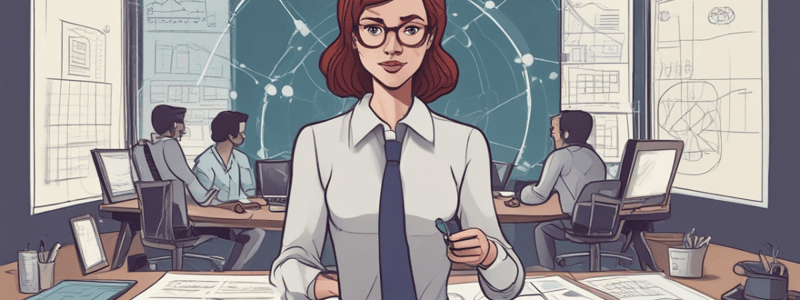Podcast
Questions and Answers
What is a key benefit of effective leadership in mechanical engineering?
What is a key benefit of effective leadership in mechanical engineering?
- Decreased productivity
- Improved teamwork (correct)
- Limited communication
- Reduced innovation
What is the primary goal of management in an organization?
What is the primary goal of management in an organization?
- To increase the workload of employees
- To reduce the number of employees
- To increase efficiency, productivity, and effectiveness (correct)
- To decrease the organizational objectives
What is the primary goal of controlling in mechanical engineering?
What is the primary goal of controlling in mechanical engineering?
- Setting performance standards
- Developing leadership styles
- Evaluating employee performance
- Monitoring and evaluating performance to ensure organizational goals are met (correct)
What is the purpose of the principles of management?
What is the purpose of the principles of management?
What type of organization structure is characterized by a traditional pyramid structure with clear, linear top-down command?
What type of organization structure is characterized by a traditional pyramid structure with clear, linear top-down command?
What is the result of specialization in tasks according to the principle of division of work?
What is the result of specialization in tasks according to the principle of division of work?
What type of organizational relationship involves direct, vertical relationships between superior and subordinate?
What type of organizational relationship involves direct, vertical relationships between superior and subordinate?
What is the primary purpose of staff relationships in an organization?
What is the primary purpose of staff relationships in an organization?
What is the relationship between authority and responsibility in management?
What is the relationship between authority and responsibility in management?
What type of organization structure is characterized by segregated divisions based on products, services, or geographic locations?
What type of organization structure is characterized by segregated divisions based on products, services, or geographic locations?
What is the importance of discipline in an organization?
What is the importance of discipline in an organization?
What is the role of management in mechanical engineering?
What is the role of management in mechanical engineering?
What is the primary benefit of a team-based organization structure?
What is the primary benefit of a team-based organization structure?
What is the function of management that involves allocating tasks to employees?
What is the function of management that involves allocating tasks to employees?
What is the primary purpose of functional relationships in an organization?
What is the primary purpose of functional relationships in an organization?
What is the primary benefit of understanding and implementing effective management concepts in mechanical engineering?
What is the primary benefit of understanding and implementing effective management concepts in mechanical engineering?
What is the outcome of effective management in an engineering project?
What is the outcome of effective management in an engineering project?
What type of organization structure combines functional and product-based divisions, with dual reporting relationships?
What type of organization structure combines functional and product-based divisions, with dual reporting relationships?
Who formulated the principles of management?
Who formulated the principles of management?
What is the multifaceted discipline that involves the strategic planning, organization, leadership, and control of resources?
What is the multifaceted discipline that involves the strategic planning, organization, leadership, and control of resources?
What is the main purpose of the Unity of Command principle in engineering teams?
What is the main purpose of the Unity of Command principle in engineering teams?
What is the primary goal of the Unity of Direction principle in mechanical engineering?
What is the primary goal of the Unity of Direction principle in mechanical engineering?
What is the primary benefit of the Subordination of Individual Interests to General Interest principle?
What is the primary benefit of the Subordination of Individual Interests to General Interest principle?
What is the primary purpose of the Remuneration principle in mechanical engineering?
What is the primary purpose of the Remuneration principle in mechanical engineering?
What is the primary goal of Centralization and Decentralization in large engineering firms?
What is the primary goal of Centralization and Decentralization in large engineering firms?
What is the primary purpose of the Scalar Chain principle?
What is the primary purpose of the Scalar Chain principle?
What is the primary benefit of the Order principle in mechanical engineering?
What is the primary benefit of the Order principle in mechanical engineering?
What is the primary purpose of the Equity principle in mechanical engineering?
What is the primary purpose of the Equity principle in mechanical engineering?
What is the primary goal of Strategic Planning in mechanical engineering?
What is the primary goal of Strategic Planning in mechanical engineering?
What is the primary purpose of Quality Management in mechanical engineering?
What is the primary purpose of Quality Management in mechanical engineering?
What is the primary focus of Scientific Management Theory?
What is the primary focus of Scientific Management Theory?
Who introduced the concept of bureaucracy in management theory?
Who introduced the concept of bureaucracy in management theory?
What is the primary focus of Human Relations Movement?
What is the primary focus of Human Relations Movement?
What is the primary goal of Total Quality Management (TQM)?
What is the primary goal of Total Quality Management (TQM)?
What is the primary function of planning in management?
What is the primary function of planning in management?
What is the primary focus of Systems Theory?
What is the primary focus of Systems Theory?
What is the primary focus of Contingency Theory?
What is the primary focus of Contingency Theory?
What is the primary focus of Operations Research?
What is the primary focus of Operations Research?
What is the primary focus of Maslow's Hierarchy of Needs?
What is the primary focus of Maslow's Hierarchy of Needs?
What is the primary function of organizing in management?
What is the primary function of organizing in management?
Flashcards are hidden until you start studying
Study Notes
Concept of Management
- Management is a multifaceted discipline that involves strategic planning, organization, leadership, and control of resources to achieve specific organizational objectives.
- It aims to increase efficiency, productivity, and effectiveness within an organization.
- Management encompasses various functions such as planning, organizing, staffing, leading, and controlling to ensure that goals are met in a timely and cost-effective manner.
Principles of Management
- Division of Work: Specialization in tasks leads to increased productivity and efficiency.
- Authority and Responsibility: Managers must have the authority to give orders and the responsibility to ensure those orders are carried out.
- Discipline: A disciplined work environment is essential for the smooth functioning of an organization.
- Unity of Command: Each employee should receive orders from only one superior to avoid confusion and conflict.
- Unity of Direction: The organization should have a single plan of action to guide managerial efforts.
- Subordination of Individual Interests to General Interest: The interests of the organization take precedence over individual interests.
- Remuneration: Fair compensation is essential for motivating employees.
- Centralization and Decentralization: The degree of centralization or decentralization depends on the organization's size and nature.
- Scalar Chain: The line of authority from top management to the lowest ranks is known as the scalar chain.
- Order: Proper arrangement of materials and personnel is crucial.
- Equity: Managers should be kind and fair to their subordinates.
- Stability of Tenure of Personnel: High employee turnover is inefficient and costly.
- Initiative: Encouraging employees to take initiative leads to innovation and continuous improvement.
- Esprit de Corps: Promoting team spirit builds harmony and unity within the organization.
Techniques of Management
- Strategic Planning: Defining long-term goals and determining the best strategies to achieve them.
- Operational Planning: Focuses on short-term objectives and the specific actions needed to achieve them.
- Budgeting: Allocates resources to various departments and projects.
- Performance Metrics: Tools such as Key Performance Indicators (KPIs) and Balanced Scorecards measure the efficiency and effectiveness of processes and activities.
- Risk Management: Identifying, analyzing, and mitigating risks is crucial to preventing project failures and ensuring safety.
- Quality Management: Ensuring that products and services meet specified quality standards.
- Project Management: Planning, executing, and closing projects.
Evolution of Management Thoughts
- Classical Management Theory:
- Scientific Management (Frederick Taylor): Emphasized efficiency through time and motion studies.
- Administrative Management (Henri Fayol): Provided a comprehensive framework for organizational management.
- Bureaucratic Management (Max Weber): Introduced the concept of bureaucracy, emphasizing a structured, rule-based approach to management.
- Behavioral Management Theory:
- Human Relations Movement (Elton Mayo): Highlighted the importance of human behavior, needs, and attitudes within the workplace.
- Maslow's Hierarchy of Needs: Abraham Maslow proposed that human needs are arranged in a hierarchy, from basic physiological needs to self-actualization.
- McGregor's Theory X and Theory Y: Douglas McGregor identified two contrasting views of workforce motivation.
- Quantitative Management Theory:
- Operations Research: Uses mathematical models and statistical techniques to solve management problems.
- Modern Management Theories:
- Systems Theory: Views the organization as a system of interrelated parts.
- Contingency Theory: Suggests that the best management practices depend on the specific circumstances.
- Total Quality Management (TQM): Focuses on continuous improvement and customer satisfaction.
Functions of Management
- Planning: Setting objectives and determining the best course of action to achieve them.
- Organizing: Arranging resources and tasks to achieve objectives.
- Leading: Directing and motivating employees to meet organizational goals.
- Controlling: Monitoring and evaluating performance to ensure that organizational goals are met.
Organization Structure & Relationship
- Organization Structure:
- Hierarchical Structure: Traditional pyramid structure with clear, linear top-down command.
- Flat Structure: Fewer levels of middle management between staff and executives.
- Matrix Structure: Combines functional and product-based divisions, with dual reporting relationships.
- Divisional Structure: Segregated by products, services, or geographic locations.
- Team-Based Structure: Emphasizes teams rather than traditional hierarchy.
- Organizational Relationships:
- Line Relationships: Direct, vertical relationships between superior and subordinate.
- Staff Relationships: Advisory and supportive roles to the line managers.
- Functional Relationships: Specialized units or departments that have authority over their specific functions.
- Lateral Relationships: Horizontal coordination between departments or divisions at the same level.
Studying That Suits You
Use AI to generate personalized quizzes and flashcards to suit your learning preferences.




